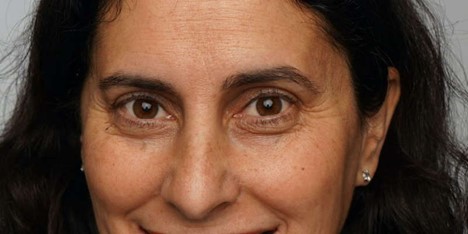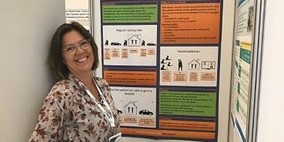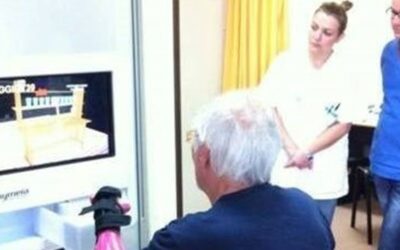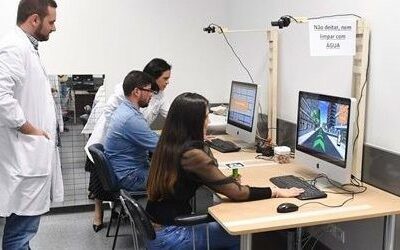Dr. Dahlia Kairy
Associate Professor
Université de Montréal, Canada
dahlia.kairy@umontreal.ca
Dr. Dahlia Kairy is an Associate Professor at the Université de Montréal. She has been publishing research examining Telemedicine and Telerehabilitation since 2008. In 2009, she was first author on an extensively cited review of telerehabilitation. Her team is currently examining the rehabilitation of persons with stroke using a telerehabilitation interface.
Gerry Fluet interviewed Dr. Kairy on June 1, 2020.
GF: Your field, telemedicine and telerehabilitation more specifically, is in the front and center of national and international discussions on healthcare. It must be interesting to have been thinking and talking about things for years and now all of a sudden, everybody is talking about them.
DK: This is actually something that fascinates me. It’s not that the field wasn’t taking off. We were getting people’s buy-in on the surface, but it was really hard to get actual buy-in in the clinical settings. The research projects were advancing and showing good results, but there were so many obstacles in the clinical settings, not just by clinicians, but in the whole healthcare system. So many obstacles and barriers that the whole field just didn’t take off. Then all of a sudden, a lot of these obstacles disappeared.
GF: With the disappearance of these obstacles in the U.S., a huge section of the healthcare quickly adopted a telemedicine approach to patient interaction with little attention to standards of practice, training or monitoring. In your opinion, are there any best practice steps that you feel clinics or practitioners that are expanding into telemedicine or telerehab should adopt?
DK: I don’t think that the literature has enough information for recommendations at that level because a majority of the published research has been efficacy studies. A little work has examined implementation, but not much. We have some good information about which clientele we could do things with and which interventions were safe. For example, one of the biases we encounter often relates to falls and safety in stroke patients. There are telerehabilitation studies training balance in persons with stroke. You can do it, but this doesn’t mean you can do it in any way you want. We have found that implementation is what people need guidance with at the beginning. Some of my research colleagues and I have done some webinars online showing clinicians what was possible, what we did to adapt or make sure that tele-rehab interventions were safe from our research experiences.
This said, I hope to learn from this quick uptake to develop best practice to give some guidelines by doing a survey of telerehabilitation use during the pandemic. I think we can learn a lot. We can look at what worked and what did not in a way that we normally can’t with our regular research study designs. There is an excellent paper by Bettger et al. that I just read. It presents public policy approaches to providing rehabilitation during the Covid-19 pandemic and telerehabilitation features prominently. This article presents many of the questions we need to be asking to position telerehabilitation in the healthcare systems more effectively going forward.
GF: There are several well-developed tele-medicine packages that have been available for years. This said, many in the U.S. are practicing right now via Facetime, Facebook, Zoom, WebEx etc. What do you feel are the most important strengths of the packages specifically designed for telemedicine and in what situations would they be the most appropriate for?
DK: So I think that the problem with the more commercial applications is that you’re at the mercy of these large companies and they make updates, they make changes, this can be difficult for small practices to to follow. In addition, he or she is not necessarily equipped to know what’s appropriate, what’s not, what’s secure, what’s not. In a time of a pandemic, some of these issues became less critical, less important. Getting patients access to services was more important than ensuring that it was necessarily secure. I don’t think this will hold in the future.
GF: Are the rehabilitation clinics in Canada adapting general telemedicine systems or systems designed specifically for telerehabilitation?
DK: What I’ve found, but that’s just my impression, is that first of all, in Canada, we have a large public health care system as well as some private services for rehabilitation. Larger practices in the private system tended to very quickly go with the commercially available telemedicine system. Some of the applications they were using before integrated these commercially available platforms, so that they ended up having one package that could do scheduling, note taking and the face to face sessions, for example. So they chose those quickly and the companies that offer them were very quick to jump on board and integrate telecommunications into their platform.
Smaller rehabilitation providers that work in the private sector have shown more interest in the telerehabilitation applications I think because they can communicate with the researchers or those who designed the systems and actually have them tailored a little bit more to their needs.
And then in the public sector, in Quebec anyways, it’s been challenging because they had to identify very quickly which platforms they would okay across the board, not just in rehab. Getting other rehab-specific systems okayed in the public system is much more challenging.
GF: In the US, a majority of the telemedicine conducted to date incorporates interviewing, vital sign monitoring, some simple exams, consultation, referral and teaching. There isn’t much if any physical activity. When we’re switching the conversation from telemedicine to telerehabilitation is there anything important to consider?
DK: This is an interesting question because that’s the main concern I’m hearing from clinicians, they are comfortable doing education but they are not certain that what they are doing is as good as what they would be doing in person. I think there’s a lot we can learn about the importance of education and getting patients more active during telerehabilitation sessions and I’m hoping to get this type of information from the survey I described. I hope that we can provide some examples to clinicians of what you can or can’t do and how to be creative and possibly provide the more hands on part of it. Of course there are certain things you can do and some you can’t. Can you have a caregiver do some of the stretches that you might do? Possibly. I think it depends on the context. The biggest message that I give the clinicians always is use your clinical judgment. That’s what prevails. If you think you can try something remotely and then decide it’s not the best way of doing it, you need to say “I’ll keep it for when I see them in person”. This isn’t a problem. Going forward I think a combination of the two, telerehabilitation and in person rehabilitation, is ideally what’s going to end up happening.
In addition, I think that people have also seen the bigger roles that education and coaching play in rehabilitation and a lot of that can be done simply with straight forward audio and video applications.
GF: In terms of published papers or books describing active telerehabilitation are there any papers or books that you would recommend?
DK: There’s nothing that could be used to guide interventions that I’m aware of. Everything I’ve seen is about the patient or the clinician’s perspective. So it’s not actually how to do it, but it’s what their thoughts are. I haven’t seen anything yet with the details of the interventions that are done. I would really like to see that.
GF: No one wants to talk about the details of interventions. In my opinion, this is a problem with rehab research in general.
DK: Yes, exactly. And then when you do your own study, it’s hard to know which were the parts that worked and which ones you should duplicate. The other thing I think would be useful would be either a review or a repository of outcome measures that you can use online. Ideally, these measures would be validated for online use, but even sharing measures that people are currently using. Clinicians are asking us that a lot and it’s very hard as researchers to encourage them to use outcome measures, which haven’t been validated for online use. I think it would be great if we could somehow benefit from the experience that’s going on to be able to say what is possible to do online and what is not.
GF: Remote outcome measures would be very helpful in my group’s work. We have subjects that have completed interventions, but we cannot collect outcome data. We’re losing data on compliant subjects.
DK: We have the same issue in our research projects. In some of the projects, we feel that we can do some of the assessments from a distance. So we are doing them so we don’t lose a subject after they’ve been in the study for eight weeks. In others we’ve had to say, okay, we can’t work with them anymore. I think we’ll see a lot of studies in the literature that will be in the same situation.
GF: Do you feel that there are important strengths or weaknesses when you’re including a VR component in a telerehabilitation intervention?
DK: I have one project where we combine the two. So they do VR and they also do VR with telerehabilitation, with the therapist watching them interacting. The VR allows the therapist to adapt the exercise program. It also allows her to use a lot of motivational strategies to get them to be adherent and use it repeatedly. The VR combined with telerehabilitation also allows the patients to integrate some of their gains into their usual daily activities.
GF: In your opinion, what does a clinician need to think about when they’re trying to include virtual reality in their telerehabilitation interventions?
DK: I think that the clinician should be looking at the level of difficulty of the activity that you give a patient. And it depends on the person because, for some people, too easy is boring and they’ll stop and if it’s too easy it will limit their gains. For others, too difficult will make them frustrated and they’ll stop. So I think it’s not one size fits all and telerehabilitation allows you to get more information about this.
GF: We’re seeing a similar heterogeneity when it comes to challenge in our subjects. The same with novelty. Some want the simulations to look different. They want different music, different visuals…… a game that changes a lot. Other people are thrilled to death with playing the same game the same way, over and over and over. Some of our subjects are asking about competition; others don’t want to compete they just want to do their best. This has been really interesting for us too.
DK: I think that all those things are what a clinician does when they choose exercises that they give a to a person in usual in-person interactions. They use their clinical reasoning. So this is what should be done using telerehabilitation. I also think that there should be a way through AI to be able to do this type of clinical reasoning using a few questions. Questions about the patient’s interests, the activities they need to improve, things like that. Use this information and apply some kind of an algorithm to give the best parameters for a game, and then ask a few more questions along the way and it adjusts the game further. I think that it’s a question of being aware that we’re not all the same, we don’t all have the same interests and this plays an important role in rehabilitation.
GF: Is there anything else you think would be interesting or important for our society to start thinking or talking about all of the telerehabilitation that’s going on currently?
DK: I know at this point, we are saying that telemedicine is going to stay after the pandemic is over. It’s interesting because right now, Montreal is still quite a hot zone, but around us it’s really not. Clinics are reopening and the therapists who were using telemedicine are now putting all their energy into setting up their clinics to be safe for in person rehabilitation. A lot have cut out the telemedicine part for now. So I’m not sure that it’s going to be as easy as we think to get people to continue using telerehabilitation. I think we’re going to have some work to do.
We are going to need to identify gaps in services and say, we know from experience that rehabilitation can be offered from a distance. So it is your responsibility, whether it’s from a distance or in person, to provide access to these underserved populations.
Also, I think it might be interesting to do a session at ICVR or a journal special issue on lessons learned from this rapid uptake of telerehabilitation. Something like that would be interesting.
(Article from the ISVR Newsletter Issue 18)




